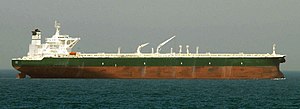Oil tanker
tanker designed for the transport of oil
An oil tanker, also known as a petroleum tanker, is a ship made for the bulk transport of oil. There are two basic types of oil tankers: the crude tanker and the product tanker. Crude tankers move large quantities of unrefined crude oil from its point of extraction to refineries. Product tankers, generally much smaller, are designed to move petrochemicals from refineries to points near consuming markets.

Bibliography change
- Central Intelligence Agency (2007). CIA World Factbook 2008. Skyhorse Publishing. ISBN 978-1602390805. Archived from the original on 2008-08-12. Retrieved 2008-02-22.
- Det Norske Veritas (2008). "Knock Nevis". DNV Exchange. Det Norske Veritas. Retrieved 2008-04-08.
- Devanney, Jack (2006). The Tankship Tromedy: The Impending Disasters in Tankers (PDF). Tavernier, FL: The CTX Press. ISBN 0-9776479-0-0.
- Douet, M (July 1999). "Combined Ships: An Empirical Investigation About Versatility". Maritime Policy and Management. 26 (3). Taylor and Francis, Ltd.: 231–248. doi:10.1080/030888399286862. Archived from the original on 2008-06-11. Retrieved 2008-04-07.
- Encyclopædia Britannica (1911). "Petroleum". In Chisholm, Hugh (ed.). Encyclopædia Britannica. Vol. 21 (11th ed.). pp. 316–322. Retrieved 2008-02-22.
- Encyclopædia Britannica (1911). "Ship". In Chisholm, Hugh (ed.). Encyclopædia Britannica. Vol. 24 (11th ed.). pp. 881–889. Retrieved 2008-02-22.
- European Commission / European Maritime Safety Agency (2005). Double Hull Tankers: High Level Panel of Experts Report.
Further reading change
- Spyrou, Andrew G. (February 2006). From T-2 to Supertanker: Development of the Oil Tanker, 1940-2000. [United States]: iUniverse, Inc. ISBN 0-595-36068-8.
- Sullivan, George (1978). Supertanker!: The Story of the World's Biggest Ships. New York: Dodd Mead. ISBN 0-396-07527-4.
- Stopford, Martin (1997). Maritime economics. New York: Routledge. ISBN 0-415-15309-3.
Other websites change
Wikimedia Commons has media related to Oil tankers.
- Bill Willis. Supertankers
- Intertanko - the society of International Tanker Operators
- The International Maritime Organization Archived 2009-07-07 at the Portuguese Web Archive - Tanker Safety (for double-hulls)
- [1] - Ship photos of tankers, ULCCs, VLCCs, barges